Endemic Birds in Sri Lanka
Lanka Haban Kukula
Local Name : The Ceylon Spurfowl
Scientific Name : Galloperdix bicalcarata (Forster)
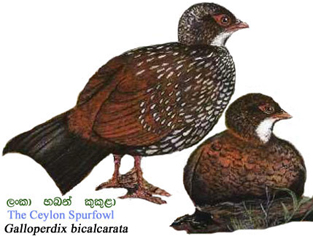
Identification
Size of a partridge, or of a half grown village fowl. The hen resembles a small, brown village chicken; the cock, with his white-spangled black foreparts and dark chestnut hinder parts, is unmistakable.
Behaviour
Strictly a forest bird, it is so shy and wary that its presence in a district would often pass quite unknown were it not for its unmistakable cry; this reveals that it is not uncommon in much of the more densely forested parts of its range. The cry is peculiar, ringing cackle, consisting of series of three-syllabled whistles.
Distinctly a ground bird. The food consists of various seeds, fallen berries, termites and other insects, and it scratches vigorously for them amongst the dead leaves, etc.,of the forest floor.
The breeding season is in the north-east monsoon, and sometimes a second brood is raised in July-September. The nest is a slight scrape in the ground in the shelter of a rock, bush, etc. The eggs from the normal clutch, but up to five have been recorded; they are cream or warm buff in colour, and exactly resemble miniature hens' eggs in appearance. They measure about 43 × 31 mm.
Location
This bird widely distributed in the southern half of the Island, both in in the hills, up to 7,000 feet, and in the low country; but is commonest in the damp rain-forests of the wet zone. It also occurs locally in riverrine forests of the dry zone, in both the northern and southern half of the island.
-------------------------------------------------------------------------------------------------
Wali Kukula
Local Name : The Ceylon Junglefowl
Scientific Name : Gallus lafayettii Lesson
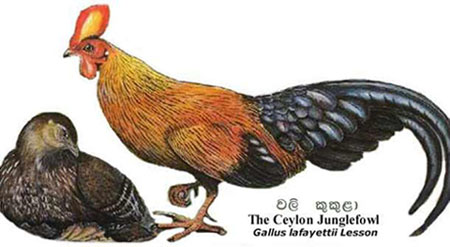
Identification
Size of a small, but not bantam, breed of domestic fowl.
Behaviour
Haban Kukula is a fairly common bird. It spends its life in forest or its outskirts, never venturing far from cover, though, especially in wet weather, it likes to frequent open places, such as roadsides or glades.The food of the Haban Kukula consists of grain, weed seeds, berries, various succulent leaves and buds, and a large proportion of small animals, such as crickets, centipedes and termites. When nillu flowers and seeds in up-country jungles, junglefowl migrate to these areas in large numbers to fatten on the abundant seed.
The main breeding season is in the first quarter of the year, but often a second clutch is laid in August-September, and breeding may go on throughout the year. The nest is often a shallow scrape in the ground, concealded by herbage, at the foot of a tree or beside a dead log. The eggs number two to four; they are creamy-white, some very finely peppered, other more boldly but sparingly speckled with brown. They measure about 48 × 35 mm.
Location
The Junglefowl is distributed throughout the Island, whenever jungle or dense scrub of any extent is to be found, but it is nowadays common only in the wilder parts of the dry zone.
-------------------------------------------------------------------------------------------------
Mailagoya
Local Name : The Ceylon Wood Pigeon
Scientific Name : Columba torringtonii

Identification
About the size of the domestic pigeon, but with a long tail. Sexes alike. Young birds are duller, and have only a trace of he black and white 'chess board' patch on the side of the neck.
Behaviour
Exclusively a forest dweller, It lives in pairs though small flocks will form where food is abundant. It is strictly arboreal, feeding on a variety of small jungle fruits and berries, among which the fruits of the wild cinnamon are much liked.
The breeding season is from February to May, and again from August to October. The nest is the usual pigeon-type, scanty platform of twigs; it is placed among foliage and twiggery in the canopy of a forest tree, or in the top of a tall sapling, usually at height of fifteen to twenty feet. The single, white egg measures about 38.5 X 28.2 mm.
Location
This handsome pigeon is confined to the hill forest of Sri Lanka, though it has a close relation (the Nilgiri Wood Pigeon), of very similar appearance and habits, in the hills of South India. It s normal range is from 3,000 feet upwards to the highest elevations, but it wanders about a great deal and sometimes descends as low as 1000 feet in the damp forests of the wet zone.
-------------------------------------------------------------------------------------------------
Lanka Giramalitta
Local Name : Sri Lanka Hanging Parrot
Scientific Name : Loriculus beryllinus (Forster)
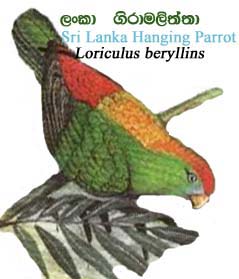
Identification
Size of a House Sparrow. Sexes alike, but the female is duller, coloured than the male, and has only a trace of pale-blue throat-patch; young birds have the head all green, but otherwise resemble their parents.
It is strictly arboreal, never descending to the ground. Although often solitary, companions are never far away, and it keeps them informed of its movements by constantly uttering, while o the wing, a sharp three-syllabled whistle twiwittwit...twitwitwit. The lorikeet is a convivial little bird, delighting in juicy fruits, the nectar of flowers(especially dadap and red cotton), and the juice of palms collected in toddy-drawers' pots.
Behaviour
The lorikeet breeds in the first half of the year, and sometimes again in July-September. Its breeding habits are highly remarkable. The eggs are white and nearly spherical, measuring about 19.3 X 16 mm.
Location
This brilliantly-coloured little parrot is found everywhere in the hills up to 4,000 feet, and in the north-east monsoon it ascends a thousand feet higher; it also inhabits the low-country wet zone and parts of the dry zone to the south of the Northern Province.
-------------------------------------------------------------------------------------------------
Lanka Alu Girawa
Local Name : Layard's Parakeet
Scientific Name : Psittacula calthrope Blyth
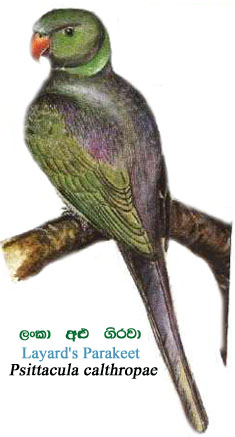
Identification
Between the Rose-ringed Parakeet and the Blossom-headed Parakeet in size. The female is duller than the male, and has the beak black. Young birds are green, with the head darker, and the lower back and rump colbalt blue; their beaks are at first dull orange, later black, from which colour that of the male gradually changes to bright scarlet of the adult. The dark grey head (green around the eye), pale grey back, and comparatively short, deep bluetail distinguish this from other Sri Lankan Parakeets.
Behaviour
Its cry is quite ditinctive.
-------------------------------------------------------------------------------------------------
Wataratu Malkoha
Local Name : The Red-Faced Malkoha
Scientific Name : Phaenicophaeus pyrrhocephalus
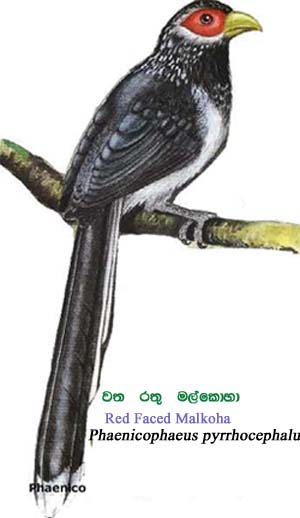
Identification
About the length of Common Coucal, but more slenderly built and with, proportionally, a much longer tail. Sexes alike, except that the female has white irides-those of the male being brown. This handsome bird cannot mistaken for any other species on the Sri Lankan list.
Location
It inhabits tall forest, and lives either solitary, in pairs, or in small flocks. It is shy and restless, a dweller in the tree canopy, where, like the last species, it cleverly threads its way through tangled twigs, creepers and foliage.
The breeding season is in the first half of the year and probably again in August-September. The nest is described as a shallow saucer of grass, roots and twigs, very carelessly put together, and placed in high bushes in forest with thick undergrowth. The two or three eggs are white, with a chalky surface, and they measure about 35.8 X 27 mm.
Location
The Red-Faced Malkoha is regularly seen at Sinharaja and few other remaining rain forests, frequents associating with feeding waves. It is also found in scattered riverine habitats in the dry zone, such as Lahugala, Wasgamuwa, Manik Ganga and Kubukkan Oya.
-------------------------------------------------------------------------------------------------
-------------------------------------------------------------------------------------------------
Lanka Pitathabala Vana-Bassa
Local Name : The Chestnut-Backed Owlet
Scientific Name : Glaucidium castanonotum

Identification
About the size of the Collared Scops Owl. Sexes alike. This little owl is very like the last species in shape, size, and general apperance but it is chestnut on back, scapulars, and wing-coverts, and has white underparts marked with blackish shaft-streaks, and bars on the flanks. Some specimens have white spots on the outer scapulars. Irides bright yellow; feet pale yellow.
Behaviour
It is shy and wary, and as it frequents the tops of tall trees, usually on steep hillsides, it is seldom seen. It is very diurnal in habits, often hunting and calling in broad daylight. The Mukalan Bassa feeds mainly on insects, such as beetles, but also captures mice, small lizards, and small birds, on occasion; most likely, the larger vertebrate forms of prey are taken only when young are being fed.
The breeding season is from March to May, the eggs being laid on the bare wood in a hole in the trunk or limb of a tree. The two glossy white eggs measure about 35 × 28.2 mm.
Location
This owl appears to have been fairly common in Legge's time in many parts of the southern half of the Island, especially the hills and wet-zone low country extending to outskirts of Colombo; but its range has undoubtedly shrunk very greatly since then, and it is now found sparingly in the remaining forests of the wet zone and adjoining hills up to 6,500 feet.
-------------------------------------------------------------------------------------------------
Lanka Bata Etikukula
Local Name : The Green Billed Coucal
Scientific Name : Centropus chlorohynchus Blyth
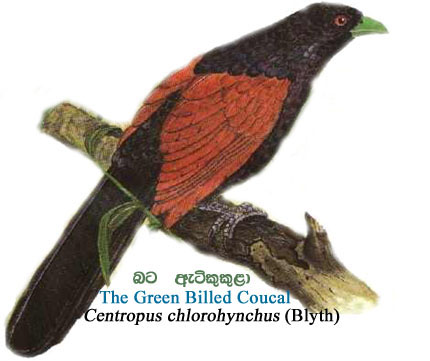
Identification
Slightly smaller than the Common Coucal, from which it may at once be distinguished by its leg, like-green beak; its wings, too, are much darker chestnut, and the sheen on the head and neck is purple, not blue. Sexes alike.
Behaviour
A very shy and elusive bird, it is far better known by its calls than by sight but, wherever the wet-zone forests have been spared the axe, it is still fairly common; its range, however, is rapidly dwindling and as it shows no sign of being able to adjust itself to new conditions, there can be no doubt that its days will soon be numbered - with those of several ither endemic forest birds - unless wise foresight reserves extensive forest sanctuaries in the wet zone.
Behaviour
This coucal is found only in the forests of the wet zone, west, south-west and south of the main mountain massif, which it ascends to 2,500 feet, or perhaps higher.
-------------------------------------------------------------------------------------------------
Home page
Copyright © 2002 Warnaka.Tripod.com, All Rights Reserved.








